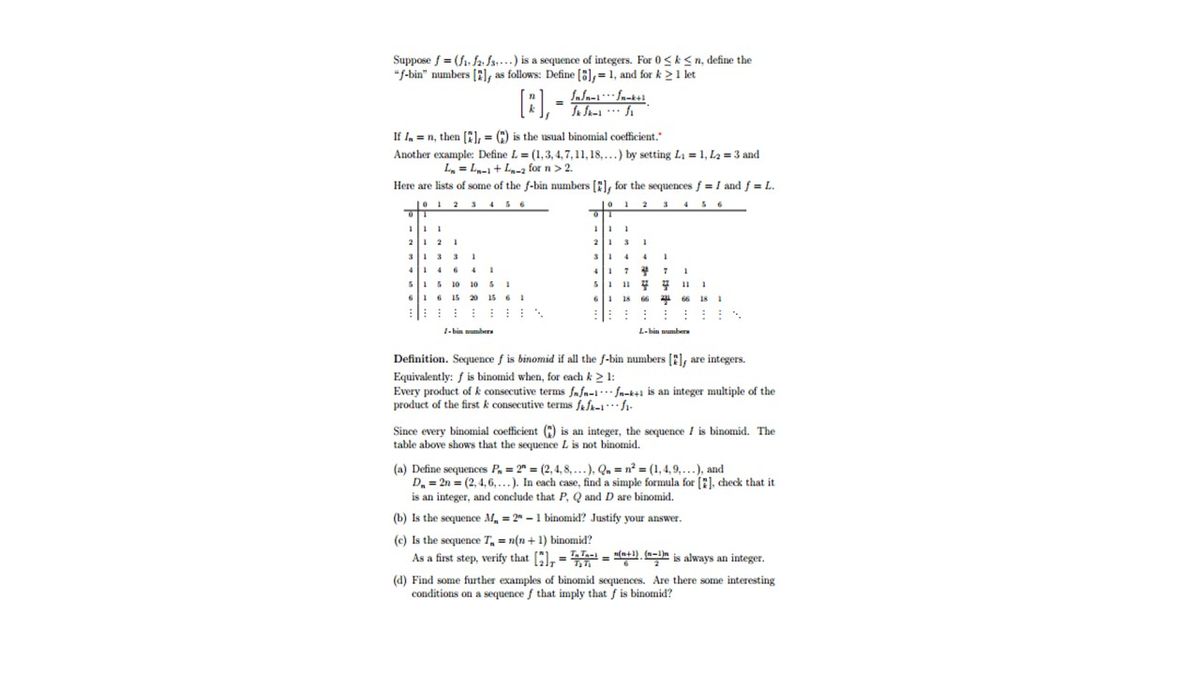Answer (a), (b), and (c) only.

2. Here are lists of some of the f-bin numbers [E), for the sequences f = I and f = L. 01 2 3 4 56 |0 12 3 345 6 21 2 I 31 33 1 5I5 10 10 SI 16 15 20 15 6 1 : :: : ::: sli 11 . 6 18 66 ::: : 1-bin sumber L-hin number Definition. Sequence f is binomid if all the f-bin numbers [2], are integers. Equivalently: f is binomid when, for each k > 1: Every product of k consecutive terms fafn-l. fn-k+1 is an integer multiple of the product of the first k consecutive terms fafk-1 fi- Since every binomial coefficient (C) is an integer, the sequence I is binomid. The table above shows that the sequence L is not binomid. (a) Define sequences P, = 2" = (2,4, 8, ...), Qa = n? = (1,4,9,...), and D. = 2n = (2, 4, 6,...). In each case, find a simple formula for [7), check that it is an integer, and conclude that P, Q and D are binomid. (b) Is the sequence M, = 2" - 1 binomid? Justify your answer. (c) Is the sequence T, = n(n + 1) binomid? As a first step, verify that [), = = ". is always an integer. (d) Find some further examples of binomid sequences. Are there some interesting conditions on a sequence f that imply that f is binomid? "/>
Extracted text: Suppose f = (f1. fa fs...) is a sequence of integers. For 0<>
2. Here are lists of some of the f-bin numbers [E), for the sequences f = I and f = L. 01 2 3 4 56 |0 12 3 345 6 21 2 I 31 33 1 5I5 10 10 SI 16 15 20 15 6 1 : :: : ::: sli 11 . 6 18 66 ::: : 1-bin sumber L-hin number Definition. Sequence f is binomid if all the f-bin numbers [2], are integers. Equivalently: f is binomid when, for each k > 1: Every product of k consecutive terms fafn-l. fn-k+1 is an integer multiple of the product of the first k consecutive terms fafk-1 fi- Since every binomial coefficient (C) is an integer, the sequence I is binomid. The table above shows that the sequence L is not binomid. (a) Define sequences P, = 2" = (2,4, 8, ...), Qa = n? = (1,4,9,...), and D. = 2n = (2, 4, 6,...). In each case, find a simple formula for [7), check that it is an integer, and conclude that P, Q and D are binomid. (b) Is the sequence M, = 2" - 1 binomid? Justify your answer. (c) Is the sequence T, = n(n + 1) binomid? As a first step, verify that [), = = ". is always an integer. (d) Find some further examples of binomid sequences. Are there some interesting conditions on a sequence f that imply that f is binomid?